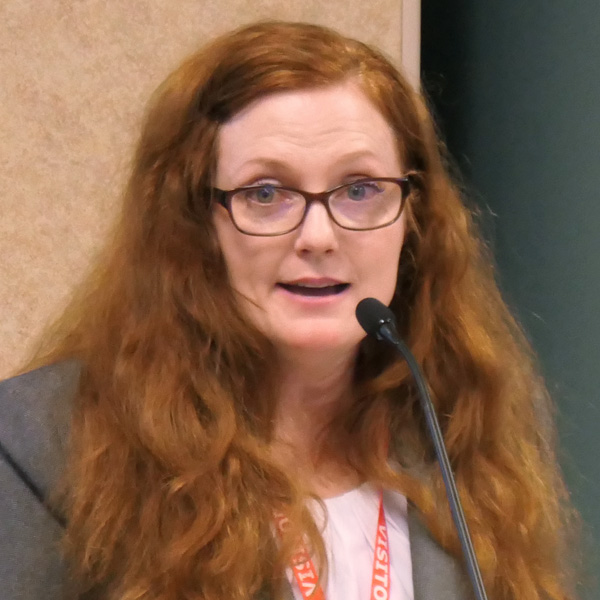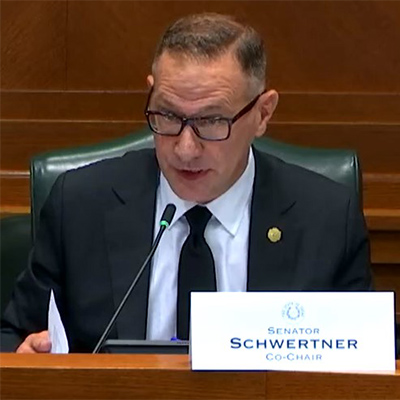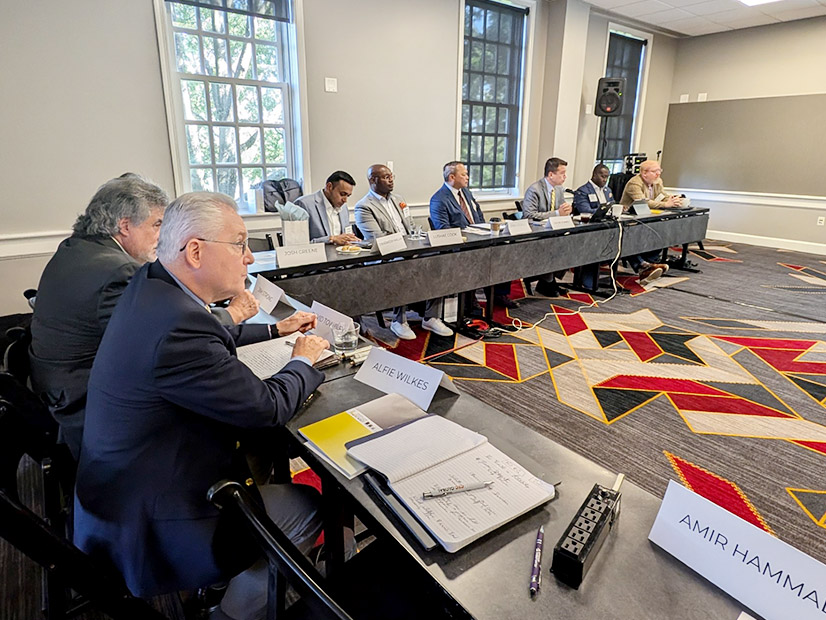CARMEL, Ind. — Demand response in MISO is poised to be subject to more rigorous standards as the Independent Market Monitor warns of more potential bad actors.
Carrie Milton, of the IMM staff, appeared before an Oct. 11 Market Subcommittee to put MISO and stakeholders on alert that MISO’s market likely contains more deceptive demand response players. It’s a warning IMM David Patton has delivered before. (See “IMM Demands Tougher Demand Response Requirements,” MISO: Hurricanes, Heat Wave Noteworthy Against Relatively Peaceful Summer.)
Milton said the IMM has “dug into” researching performance of MISO’s demand response since fraud in MISO’s DR markets emerged three times within the past two years. (See FERC Catches Ketchup Caddy Co. in Another Fake DR Scheme in MISO.)
Milton said a review of Demand Response Resource Type I performance from 2023 to 2024 showed that those resources fall short of the amounts they promise. She said of 213 spinning reserve deployments across 22 event days in 2023-2024, more than 40% of the DRR Type I resources did not perform adequately. About 200 MW of DRR Type I participates regularly in energy and ancillary services.
FERC recently uncovered three companies manipulating MISO’s demand response market and collecting unwarranted payments. The commission found that an air separation facility in Indiana accepted payments for fabricated load reductions, an Arkansas steel mill for years made faux use reductions, and an obscure, Texas-based LLC formed to sell in-car ketchup holders fraudulently enrolled customers and made sham DR offers in three capacity auctions.
Milton said demand response that fails to respond to MISO’s calls for spinning reserve deployments faces only small penalties and, in some cases, still receives make-whole payments, “eliminating any incentive to curtail.”
“We have a lot of concerns about this. MISO’s rules, penalties and participant conduct all raise concerns for us,” Milton said.
She also said the Batch-Load Demand Response category, introduced by MISO in 2020, contains the worst performers.
“This class of DR is cycling load that agrees not to increase rather than to curtail,” Milton said.
Milton also said MISO’s practice of accepting mock tests instead of actual performance testing “presents serious opportunities” for misrepresenting a resource’s abilities. She said up to 25% of DR resources submit mock tests for accreditation.
“Since 2019, our demand response has received over $800 million in capacity payments. That’s a lot of money,” Milton said.
Milton repeated Patton’s asks that MISO eliminate mock testing and the batch-load demand response category, intensify penalties and automate validation of end-use registrations so end-use customers can’t contract with multiple market participants. She also asked MISO to require utility-grade meters and five-minute data for DR providing reserves.
Stakeholders warned that the IMM’s recommendations might make DR participation in the MISO markets unattractive.
Louisiana Public Service Commission staffer Robert Vosberg said he wanted the IMM to quantify the impacts of its recommendations on ratepayers’ bills.
Jim Dauphinais, an attorney representing multiple industrial customers in MISO, asked for a “less intrusive” list of recommendations.
“If we make this too difficult for customers, they will exit the program,” WEC Energy Group’s Chris Plante warned. He added that if “even half” of the 7 GW seasonal average of demand response that cleared the MISO capacity auction this year fails to participate, MISO will be in hot water.
“We just want it to be reliable,” Milton said of demand response. “It needs to be reliable, and MISO needs to be able to count on it. That’s the crux of this. … We need to make sure that these are legitimate resources that exist and are capable of curtailing load when called upon.”
MISO plans to beef up its demand response participation rules and hopes to have the stepped-up requirements in place by next year. (See MISO Subcommittee to Act on Bad Actor Demand Response.)
MISO adviser Michael Robinson remarked that demand response has been getting more attention lately.
“It’s almost like we should have a joint Resource Adequacy Subcommittee and Market Subcommittee meeting on demand response,” he joked.
Robinson said while MISO already has rules to discourage demand response frauds, the recent instances mean it wouldn’t hurt to do more to discourage artificially inflated baselines, fraudulent registrations and artificial curtailments.
Robinson prefaced his comments by invoking a recent trip to a western Michigan orchard. He said when storing apples for the winter, one periodically should go through the bushels to look for bad apples.
“We are responding to essentially three bad apples that FERC has identified. And if you listened to the Market Monitor this morning, there are probably a few more,” Robinson said.
In August, Robinson jokingly invoked Dire Straits 1985 rock song “Money for Nothing” to describe the three recent schemes.
The rules will impel market participants to prove their legitimacy annually by sharing their contractual agreements with MISO. They also will require regularly updated meter data alongside attestation of baseline use. MISO will screen offer parameters and stop allowing whole event days to be precluded from the baseline calculation and instead use just the hours where LMRs responded.
MISO’s IMM also would assess demand response for withholding and create reference level calculations for demand response resources.
New LMR Accreditation Looks Certain
A more exacting accreditation remains on the way for MISO’s load-modifying resources over members’ objections.
MISO said staff will make a final presentation in November before filing the new LMR accreditation with FERC.
The RTO plans to accredit its load-modifying resources based on their past performance levels by the 2028/29 planning year. It said it will split LMRs into two categories — those that can respond in 30 minutes or less and those that can’t — and accredit them accordingly. (See MISO Tries to Win over Stakeholders on New LMR Capacity Accreditation; MISO Proposes to Split LMR Participation, Accreditation into Fast/Slow Groups.)
MISO’s LMR Type II category would have a maximum response time of 30 minutes and presumed availability for all of MISO’s maximum generation emergency step two events.
Conversely, an LMR Type I class would carry a maximum response time of six hours and be called up earlier, when MISO declares a maximum generation alert. MISO has long said it needs to be able to access LMRs outside of actual emergency declarations.
MISO plans to use a similar accreditation with its availability-based method for its more traditional generation resources. However, to measure demand response, MISO said it will use backward-looking meter data from hours when capacity advisory declarations are in place to accredit resources. The RTO plans to draw on data from a minimum of 65 historical hours per season over the past year and will give more weight in accreditation to performance during hours where capacity advisories escalated into maximum generation events, alerts or warnings.
MISO said it will cap accreditation at an LMR’s maximum stated capability during registration. The RTO also said it will reduce accreditation when LMR owners submit inaccurate availability information. Currently, MISO doesn’t tie the accuracy of LMR availability data to accreditation values.
The new accreditation model will put an end to demand resources being free to dual register as both LMRs that collect capacity payments and demand response resource types, which receive energy payments.
Joshua Schabla, a MISO market design economist, said MISO’s proposed accreditation design appropriately allows for “diversity of performance and diversity of characteristics.”
At an Oct. 9 Resource Adequacy Subcommittee meeting, Schabla said in addition to the usual large factories and mills, MISO’s LMRs also include about 250 resources that are 1 MW or smaller. He said the availability-based accreditation will keep smaller LMRs participating alongside the sites capable of significant load reductions.
“We do think that our overall design captures as much of this as reasonable,” Schabla said. He added that it’s difficult to keep the design simple because of the array of MISO’s LMR types.
Schabla said MISO remains convinced it needs to call on its longest-lead LMRs during maximum generation alerts rather than when actual emergencies arrive.
“We’re trying to incentivize more rapid response time. For longer lead resources to be effectively utilized, MISO needs the capability to deploy them earlier. … If you have a six-hour lead time, we need to deploy you earlier to effectively use you,” he said.
Plante said most of WEC Energy Group’s large industrial customers aren’t comfortable with a 30-minute lead time, citing safety concerns with powering down so quickly. On the other hand, Plante said WEC’s slower-moving LMRs are uneasy with the risk exposure of being called up six hours ahead of when they’re needed. Plante said a two- or even five-hour notification might be more suitable.
“What I’m hearing is neither option is really viable,” Plante said.
MISO and stakeholders sparred over the RTO’s goal to discontinue use of LMRs being able to use a firm service level option to participate. MISO’s firm service level option currently allows LMRs to select a prespecified baseline when registering, agreeing not to use more than that during emergencies. Unlike other LMRs, those using firm service level must curtail all nonfirm load from the system, rather than deducting a megawatt amount from a baseline demand.
Several stakeholders said MISO should preserve the firm service level option, calling it a cornerstone of LMR use in MISO. Dauphinais, the attorney representing multiple industrial customers in MISO, said it would be a “fatal flaw” to cut the participation option.
“We don’t see stated availability moving as fast as we see these loads moving,” Schabla explained. He said MISO needs a more accurate measurement of LMR capability.
Schabla said MISO expects there to be a “tolerance band” around the actual reductions LMRs can make, using the fluctuating draw of air conditioning programs as an example.
“By no means are we expecting you to know exactly what you can provide. We expect you to tell us, within a margin, of what you can give us,” Schabla said.
Multiple MISO stakeholders derided MISO’s reliance on its Demand Side Resource Interface tool for availability data. They complained that the DSRI, which recently replaced the MISO Communication System for communicating LMR availability, is not well understood and that members could use training sessions.
Schabla said he agreed MISO should provide member training on the system sooner rather than later.


